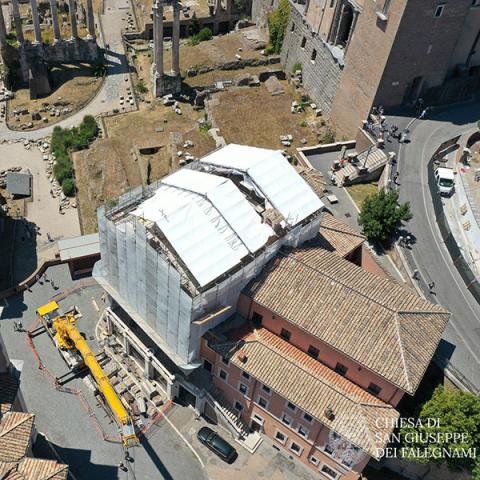ali.creta_3112
SOSTENIBILITÀ ALLA CHIESA DI SAN GIUSEPPE DEI FALEGNAMI
La chiesa di San Giuseppe dei Falegnami che sorge sopra il Carcere Mamertino, nel cuore del Foro Romano, fu eretta nella prima metà del XVII secolo e fu oggetto di lavori di restauro conclusi nel 1884, consegnandoci l’aspetto che oggi conosciamo. Il 30 agosto 2018 parte della copertura ha ceduto causando il crollo di parte del cassettonato ligneo dorato, decorato con elementi scultorei della Natività e dei Santi Pietro e Paolo, e del pavimento marmoreo dell’aula della Chiesa. Una volta conclusi i lavori di messa in sicurezza, è stato avviato il cantiere di restauro vero e proprio che ha avuto, fin da subito, come obiettivo quello di garantire la sostenibilità delle lavorazioni, applicando e talvolta superando i Criteri Minimi Ambientali richiesta dalla normativa vigente. La Chiesa è il primo esempio di edificio di culto ad aderire al protocollo GBC Historic Building®, rappresentando un vero e proprio caso di studio.
SUSTAINABILITY AT THE CHURCH OF SAN GIUSEPPE DEI FALEGNAMI
The church of San Giuseppe dei Falegnami is located on top of the Mamertine Prison, at the heart of the Roman Forum. It was built in the first half of the 17th century and what we see today is the result of restoration work concluded in 1884. On 30 August 2018 the roof collapsed, as did a part of the gilded coffered ceiling, which was decorated with carved elements from the Nativity and the Saints Peter and Paul, as well as the marble floor of the nave. As soon as the safety measures had been completed, the restoration work began, which from the beginning aimed to guarantee the sustainability of the work by the application of, and in some cases exceeding, the “Criteri Minimi Ambientali” required by current legislation.This Church is the first example of the restoration of a religious building adhering to the GBC Historic Building® protocol and will be a model for projects in the future.

